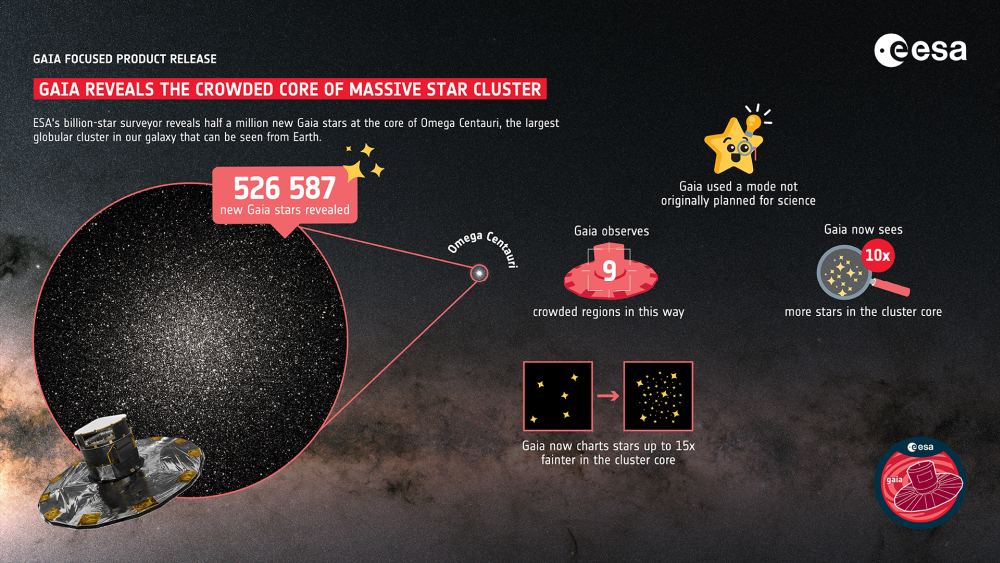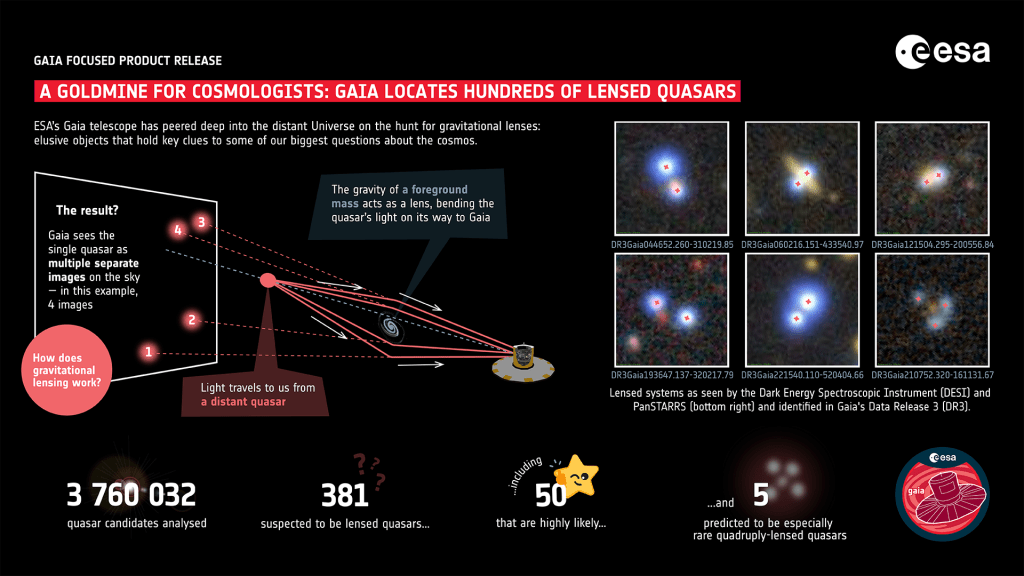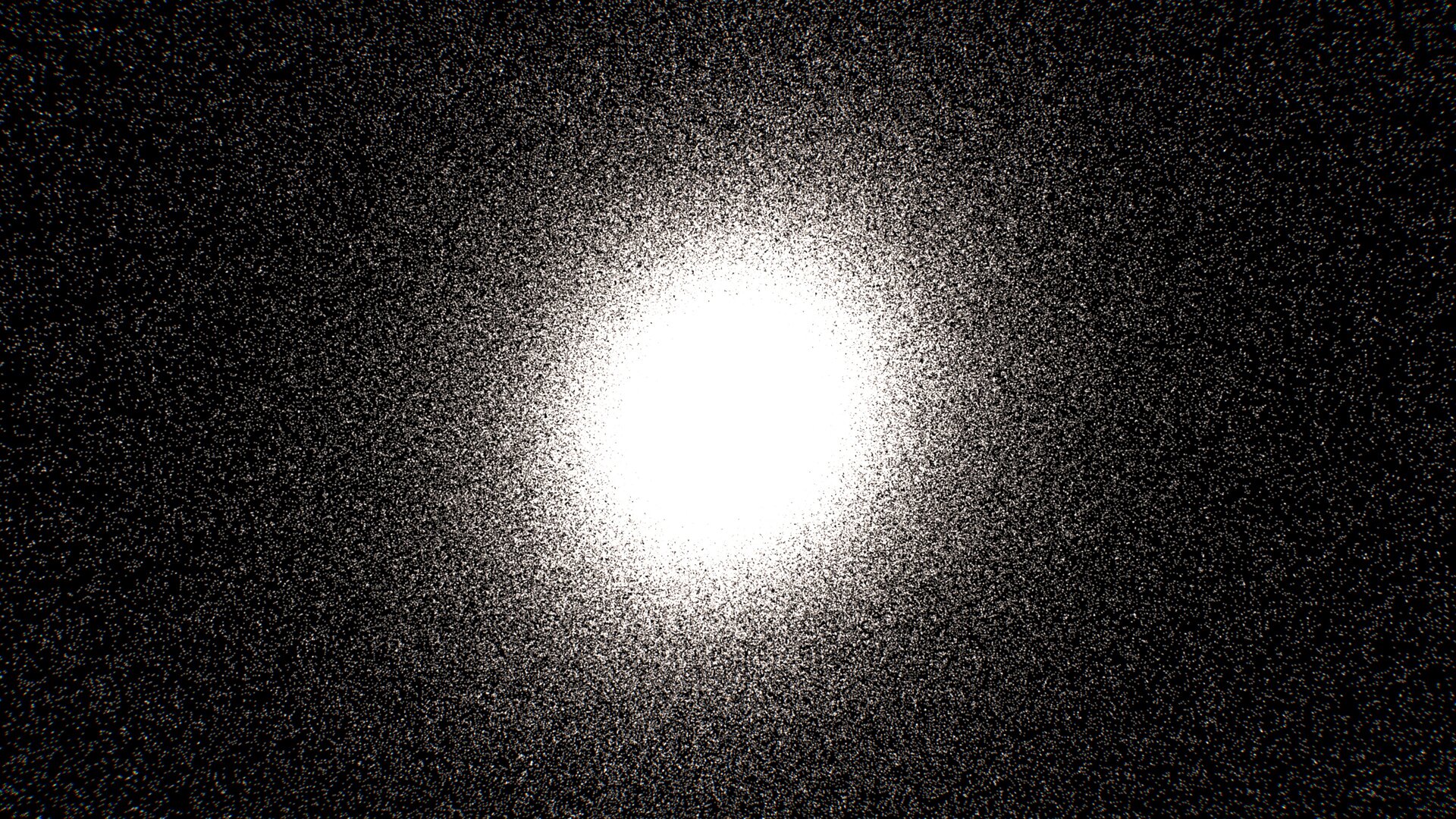The ESA’s Gaia mission is releasing a new tranche of astronomical data. The mission has released three regular, massive hauls of data since it launched in 2013, named Gaia DR1, DR2, and DR3. The ESA is calling this one a ‘focused product release,’ and while it’s smaller than the previous three releases, it’s still impactful.
The Gaia mission can fly under the radar for most of us. It doesn’t generate gorgeous images that work their way through the internet like the James Webb Space Telescope or the Hubble. Instead, it makes a muscular contribution in the form of foundational, raw data that affects a wide array of issues in astronomy and astrophysics.
Gaia’s mission is simple: it measures the motions, distances, and positions of a billion stars with extreme precision, known collectively as astrometry. Along the way, it also measures the positions of some exoplanets. Its goal is to paint our most detailed picture of the Milky Way yet and to reveal new perspectives on our place in the Universe.
In this new targeted release, Gaia covered up some gaps in its previous coverage, including regions where stars are tightly packed together. Gaia does its work by examining individual stars. But in this release, it turned its attention to other things, including globular clusters.
“We’ve deployed this amazing cosmic tool at maximum power.”
Alexey Mints, Gaia Collaboration Member
Globular clusters (GCs) are ancient, spheroidal groups of stars bound together by gravity. They can contain millions of stars and are found in galaxies, including our own. Omega Centauri was the first GC humanity knew about, though in antiquity, we thought it was a single star. It’s 17,000 light years away and has about 10 million member stars.
The ESA decided to put Gaia to work on Omega Centauri, also called NGC 5139.

Omega Centauri is regarded as a typical GC, and it’s also the most massive one in the Milky Way. To study it, the ESA used a testing and calibration mode on the observatory that wasn’t designed for science. “We didn’t expect to ever use it for science, which makes this result even more exciting,” said Katja Weingrill of the Leibniz Institute for Astrophysics in Potsdam, Germany. Weingrill is also a member of the Gaia collaboration and the lead author of one of several papers presenting the new results.
The observing mode differs because it doesn’t focus on individual stars. Instead, it mapped a wide patch of sky that included Omega Centauri. The observatory added over half a million new stars it hadn’t seen before.
“In?Omega?Centauri,?we?discovered?over?half?a?million?new?stars?Gaia hadn’t?seen?before?– from?just?one?cluster!” said Weingrill.

It turns out that Gaia’s engineering mode can make a contribution that the observatory’s regular observing mode can’t. The stars in Omega Centauri’s center are so tightly packed that they’re difficult to distinguish. But not in engineering mode.
“It’s not just patching up holes in our mapping, although this is valuable in itself,” added co-author and Gaia Collaboration member Alexey Mints, also of the AIP. “Our data allowed us to detect stars that are too close together to be properly measured in Gaia’s regular pipeline. With the new data, we can study the cluster’s structure, how the constituent stars are distributed, how they’re moving, and more, creating a complete large-scale map of Omega Centauri. It’s using Gaia to its full potential – we’ve deployed this amazing cosmic tool at maximum power.”

Omega Centauri is ancient. Its stars are between 10 and 12 billion years old. GC’s role in the evolution of galaxies is unclear, as are their origins. They may be remnants of galaxy mergers, but scientists aren’t certain. This robust new data from Gaia may help answer our questions about GCs as it has with other issues in astronomy.
Gaia is going to use its engineering mode to explore eight more regions similar to Omega Centauri. Those results will be included in the upcoming DR4, due sometime after 2025.
The splendid Omega Centauri isn’t the only target in Gaia’s new release. Though it was never intended to study cosmology, the observatory looked deep into the Universe and found gravitational lenses. Gravitational lenses are extraordinarily massive objects like galaxy clusters. Their mass bends and magnifies the light, and when they’re between us and an object even more distant than the lens, we can see the distant object of interest.

Gravitational lenses allow astronomers to see extremely distant objects as long as everything lines up right. Einstein’s theory of general relativity predicted their existence, and now they’re one more tool in astronomers’ toolboxes. They bring objects that are ordinarily too distant to observe within range. Distant, puzzling quasars are one of the objects that gravitational lenses bring into view.
Gaia found almost 400 candidate quasars and 50 that are almost certainly quasars.
“Gaia is a real lens-seeker,” said Christine Ducourant?of Laboratoire d’Astrophysique de Bordeaux, France, and a member of the Gaia collaboration. “Thanks to Gaia, we’ve found that some of the objects we see aren’t simply stars, even though they look like them. They’re actually really distant lensed quasars – extremely bright, energetic galactic cores powered by black holes. We now present 381 solid candidates for lensed quasars, including 50 that we deem highly likely: a goldmine for cosmologists and the largest set of candidates ever released at once.”
Gaia also uncovered five quasars that are quadruply-lensed. These are extremely rare and play an important role in understanding dark matter halos, regions of dark matter uncoupled from the Universe’s expansion.

Lensed quasars are difficult to see. Their images can clump together and become indistinct. They’re challenging to search for, but not for Gaia.
“The great thing about Gaia is that it looks everywhere, so we can find lenses without needing to know where to look,” said Laurent Galluccio of Université Côte d’Azur, France, and member of the Gaia collaboration. “With this data release, Gaia is the first mission to achieve an all-sky survey of gravitational lenses at high resolution.”
The elegant thing about space observatories like Gaia is how their results fuel the efforts of other telescopes and observatories. Just as the Hubble Telescope helped pave the way for the JWST, Gaia is helping pave the way for another ESA mission, Euclid. Euclid launched in July 2023 with a cosmological survey mission. Its job is to make a 3D map of the Universe based on billions of galaxies. It’s like Gaia, but it’ll map galaxies instead of stars. Gaia’s lensed quasars can help Euclid’s observations.
Several new research papers present Gaia’s new results, and they focus on things like asteroids and variable stars.
Gaia’s DR3 from June 2022 contained 150,000 asteroids. The new focused release provides more information on these asteroids by watching them for a longer period of time. These extended observations produced more detailed orbits for the asteroids that are 20 times as precise.

A more precise understanding of asteroid orbits is valuable for different reasons. One is that we don’t want one to hit us, and interdiction depends on accurate orbital data. But asteroids are also fascinating objects of scientific study that can tell us a lot about how the Solar System formed. Improved orbits could lead to more missions to asteroids to study them and even sample them. Astronomers can only calculate potential positions for many asteroids, and Gaia’s new data increases accuracy by reducing the number of potential positions.
The final subject in Gaia’s focused release is variable stars. Their brightness fluctuates in two ways. Either it’s due to something external, like a cloud of dust passing in front of the star, or something internal to the star, like swelling or shrinking. The two types of variables are called extrinsic and intrinsic variables. Variable stars are important to astrophysics because they can give us information about stellar properties like mass, radius, luminosity, temperature, internal and external structure, composition, and evolution. We don’t have any other way to acquire some of this information except from the study of variable stars.
In its new focused data release, Gaia delivered data on 10,000 variable stars. Variable stars are also key tools in determining cosmic distances, so having better data on such a massive number of variable stars will eventually help lead to a better understanding of the cosmic ladder.

“The mission is providing a truly unique insight into the Universe and the objects within it.”
Timo Prusti, Gaia Project Scientist.
“This data release further demonstrates Gaia’s broad and fundamental value – even on topics it wasn’t initially designed to address,” said Timo Prusti, Project Scientist for Gaia at ESA.
Gaia is a star surveyor at heart, and it excels at it. But this focused data release shows that it’s capable of an even larger contribution. “Although its key focus is as a star surveyor, Gaia is exploring everything from the rocky bodies of the Solar System to multiply imaged quasars lying billions of light-years away, far beyond the edges of the Milky Way,” said Prusti. “The mission is providing a truly unique insight into the Universe and the objects within it, and we’re really making the most of its broad, all-sky perspective on the skies around us.”
Gaia can get lost in the deluge of headlines from telescopes like the James Webb and the Hubble and even from installations as arcane as neutrino observatories. But it keeps chugging along, and instead of generating headlines, it generates bedrock knowledge that feeds into all sorts of research. It’s becoming increasingly rare to encounter published research in astronomy and astrophysics that doesn’t rely, even in some small way, on Gaia’s foundational data.
It’s nice to see Gaia be the star of the show, even if it’s only for a short time.

